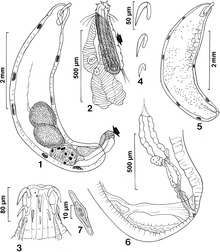Neoechinorhynchus Last updated March 11, 2025 Genus of worms
Neoechinorhynchus Neoechinorhynchidae . [ 1]
The genus has cosmopolitan distribution . [ 1]
Neoechinorhynchus Stiles and Hassall, 1905 has two subgenera, Hebesoma and Neoechinorhynchus , with 116 known species:
Neoechinorhynchus afghanus František Moravec (parasitologist)|Moravec and Amin, 1978Neoechinorhynchus aldrichettae Edmonds, 1971 Neoechinorhynchus ampullata Amin, Ha and Ha, 2011 Neoechinorhynchus argentatus Chandra, Hanumantha-Rao and Shyamasundari, 1984 Neoechinorhynchus bangoni Tripathi, 1959 Neoechinorhynchus brayi Bilqees, Shaikh and Khan, 2011 Neoechinorhynchus cirrhinae Gupta and Jain, 1979 Neoechinorhynchus coiliae Satyu Yamaguti|Yamaguti , 1939Neoechinorhynchus cyanophyctis Kaw, 1951 Neoechinorhynchus devdevi (Datta, 1936) Neoechinorhynchus glyptosternumi Fotedar and Dhar, 1977 Neoechinorhynchus hartwichi Golvan, 1994 Neoechinorhynchus hutchinsoni Datta, 1936 Neoechinorhynchus ichthyobori Saoud, El-naffar, Abu-sinna, 1974 Neoechinorhynchus indicus Gudivada, Chikkam and Vankara, 2010 Neoechinorhynchus karachiensis Bilgees, 1972 Neoechinorhynchus logilemniscus Satyu Yamaguti|Yamaguti , 1954Neoechinorhynchus magnus Southwell and Macfie, 1925 Neoechinorhynchus mexicoensis Pinacho-Pinacho, Sereno-Uribe and García-Varela, 2014 Neoechinorhynchus miniovalis Amin, Ali and Adday, 2024 [ 2] This parasite was found infesting the Mudskipper (Boleophthalmus dussumieri ) in Shatt Al-Basrah Canal Southern Iraq. [ 2]
Neoechinorhynchus nematalosi Tripathi, 1959 Neoechinorhynchus nigeriensis Farooqi, 1981 Neoechinorhynchus ningalooensis Pichelin and Cribb, 2001 Neoechinorhynchus octonucleatus Tubangui, 1933 Neoechinorhynchus oreini Fotedar, 1968 Neoechinorhynchus ovalis Tripathi, 1959 Neoechinorhynchus personatus Tkach, Sarabeev and Shvetsova, 2014 Neoechinorhynchus roonwali Datta and Soota, 1963 Neoechinorhynchus saginatus Van Cleave and Bangham, 1949 Neoechinorhynchus simansularis Roytman, 1961 Neoechinorhynchus topseyi Podder, 1937 Neoechinorhynchus tsintaoense Morisita, 1937 Neoechinorhynchus veropesoi Melo, Costa, Giese, Gardner and Santos, 2015 Neoechinorhynchus yamagutii Tkach, Sarabeev and Shvetsova, 2014 Neoechinorhynchus zacconis Satyu Yamaguti|Yamaguti , 1935Hebesoma Van Cleave, 1928 Hebesoma is a subgenus in the genus Neoechinorhynchus which contains 15 known species.
Neoechinorhynchus agilis (Rudolphi, 1819) Neoechinorhynchus anguillum El-Damarany, 2001 Neoechinorhynchus carinatus Buckner and Buckner, 1993 Neoechinorhynchus chrysemydis Cable and Hopp, 1954 Neoechinorhynchus didelphis Amin, 2001 Neoechinorhynchus doryphorus Van Cleqve and Bangham, 1949 Neoechinorhynchus idahoensis Amin and Heckmann, 1992 Neoechinorhynchus kallarensis George and Nadakal, 1978 Neoechinorhynchus lingulatus Nickol and Ernst, 1987 Neoechinorhynchus manasbalensis Kaw, 1951 Neoechinorhynchus manubrianus Amin, Ha and Ha, 2011 Neoechinorhynchus pungitius Dechtiar, 1971 Neoechinorhynchus rostratus Amin and Bullock, 1998 Neoechinorhynchus spiramuscularis Amin, Heckmann and Ha, 2014 Neoechinorhynchus violentus (Van Cleave, 1928) Neoechinorhynchus Hamann, 1892 Neoechinorhynchus is a subgenus in Neoechinorhynchus which contains 66 known species.
Neoechinorhynchus acanthuri Farooqi, 1980 Neoechinorhynchus africanus Troncy, 1970 Neoechinorhynchus armenicus Mikailov, 1975 Neoechinorhynchus ascus Amin, Ha and Ha, 2011 Neoechinorhynchus australis Van Cleave, 1931 Neoechinorhynchus brentnickoli Monks, Pulido-Flores and Violante-Gonzalez, 2011 Neoechinorhynchus buttnerae Golvan, 1956 Neoechinorhynchus carassii Roytmann, 1961 Neoechinorhynchus carpiodi Dechtiar, 1968 Neoechinorhynchus chelonos Schmidt, Esch, and Gibbons, 1970 Neoechinorhynchus chilkaense Podder, 1937 Neoechinorhynchus chimalapasensis Salgado-Maldonado, 2010 Neoechinorhynchus crassus Van Cleave, 1919 Neoechinorhynchus cristatus Lynch, 1936 Neoechinorhynchus curemai Noronha, 1973 Neoechinorhynchus cylindratus (Van Cleave, 1913) Neoechinorhynchus dattai Golvan, 1994 Neoechinorhynchus dimorphospinus Amin and Sey, 1996 Neoechinorhynchus distractus Van Cleave, 1949 Neoechinorhynchus dorsovaginatus Amin and Christison, 2005 Neoechinorhynchus edmondsi Golvan, 1994 Neoechinorhynchus emydis (Leidy, 1851) Neoechinorhynchus emyditoides Fisher, 1960 Neoechinorhynchus formosanus Harada, 1938 Neoechinorhynchus gibsoni Khan and Bilqees, 1989 Neoechinorhynchus golvani Salgado-maldonado, 197 Neoechinorhynchus iraqensis Amin, Al-Sady, Mhaisen and Bassat, 2001 Neoechinorhynchus johnii Satyu Yamaguti|Yamaguti , 1939 [ 3] Neoechinorhynchus limi Muzzall and Buckner, 1982 Neoechinorhynchus macronucleatus Machado, 1954 Neoechinorhynchus magnapapillatus Johnson, 1969 Neoechinorhynchus mamesi Pinacho-Pinacho, Pérez-Ponce de León and García-Varela, 2012 Neoechinorhynchus moleri Barger, 2005 Neoechinorhynchus nawazi Naqvil, Aly Khan, Ghazi and Noor-un-Nissa, 2012 Neoechinorhynchus nickoli Khan, Bilqees, Noor-Un-Nisa, Ghazi and Ata-Ur-Rahim, 1999 Neoechinorhynchus notemigoni Dechtiar, 1967 Neoechinorhynchus panucensis Salgado-Maldonado, 2013 Neoechinorhynchus paraguayensis Machado-Filho, 1959 Neoechinorhynchus pimelodi de Carvalho and Cezar-Pavanelli, 1998 Neoechinorhynchus plagiognathoptis Wang and Zhang, 1987 Neoechinorhynchus plaquensis Amin, Ha and Ha, 2011 Neoechinorhynchus prochilodorum Nickol and Thatcher, 1971 Neoechinorhynchus prolixoides Bullock, 1963 Neoechinorhynchus prolixus Van Cleave and Timmons, 1952 Neoechinorhynchus pseudemydis Cable and Hopp, 1954 Neoechinorhynchus pterodoridis Thatcher, 1981 Neoechinorhynchus qatarensis Amin, Saoud and Alkuwari, 2002 Neoechinorhynchus quinghaiensis Liu, Wang, and Yang, 1981 Neoechinorhynchus rigidus (Van Cleave, 1928) Neoechinorhynchus robertbaueri Amin, 1985 Neoechinorhynchus roseum Salgado and Maldonado, 1978 Neoechinorhynchus rutili (Mueller, 1780) Neoechinorhynchus salmonis Ching, 1984 Neoechinorhynchus saurogobi Yu and Wu, 1989 Neoechinorhynchus schmidti Barger, Thatcher and Nickol, 2004 Neoechinorhynchus sootai Bhattacharya, 1999 Neoechinorhynchus strigosus Van Cleave, 1949 Neoechinorhynchus stunkardi Cable and Fisher, 1961 Neoechinorhynchus tenellus (Van Cleave, 1913) Neoechinorhynchus tumidus Van Cleave and Bangham, 1949 Neoechinorhynchus tylosuri Satyu Yamaguti|Yamaguti , 1939Neoechinorhynchus venustus Lynch, 1936 Neoechinorhynchus villoldoi Vizcaino, 1992 Neoechinorhynchus wuyiensis Wang, 1981 Neoechinorhynchus zabensis Amin, Abdullah and Mhaisen, 2003 Neoechinorhynchus yalei (Datta, 1936) References 1 2 "Neoechinorhynchus Hamann, 1905" . www.gbif.org . Retrieved 5 March 2021 . 1 2 Amin, O. M., Ali, A. H., & Adday, T. K. (2024). The Description of Neoechinorhynchus miniovalis n. sp.(Acanthocephala: Neoechinorhynchidae) from the Mudskipper Boleophthalmus dussumieri Valenciennes (Gobiiformes: Oxudercidae) in Shatt Al-Basrah Canal Southern Iraq. Acta Parasitologica, 69(1), 409-414. ↑ Amin, Omar M.; Chaudhary, Anshu; Heckmann, Richard; Ha, Nguyen V.; Singh, Hridaya S. (2019). "Redescription and molecular analysis of Neoechinorhynchus (Neoechinorhynchus) johnii Yamaguti, 1939 (Acanthocephala, Neoechinorhynchidae) from the Pacific Ocean off Vietnam" . Parasite . 26 : 43. doi : 10.1051/parasite/2019041 . ISSN 1776-1042 . PMC 6650202 . PMID 31335314 .
This page is based on this
Wikipedia article Text is available under the
CC BY-SA 4.0 license; additional terms may apply.
Images, videos and audio are available under their respective licenses.
